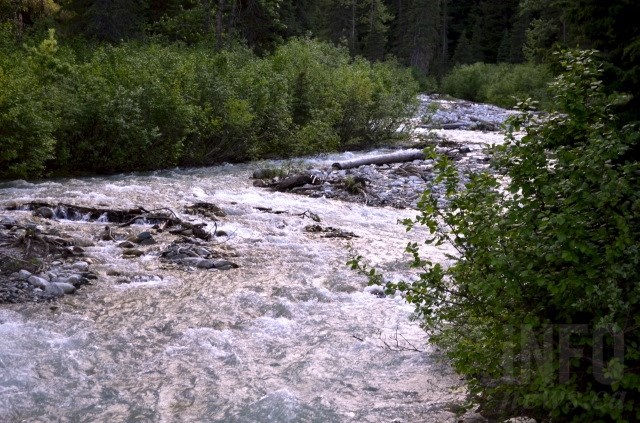
(CHARLOTTE HELSTON / iNFOnews.ca)
April 21, 2016 - 1:00 PM
HIGH WATER FLUSHING ORGANICS AND BACTERIA DOWNSTREAM INTO SOME WATER SYSTEMS
THOMPSON-OKANAGAN - Spring runoff has long been a problem for water utilties who use surface water as their source and early high water like Southern Interior streams and lakes are seeing now tends to make the problem worse.
That’s when complaints of brown, gritty water coming pouring in and the Interior Health Authority begins issuing water quality advisories or the more extreme boil water notice.
Infrastructure programs manager Ivor Nolin says some water utilities, especially smaller systems, lack the physical filtration systems necessary to screen off the bits of organic material that turn the water brown and can harbor bacteria and protozoa.
“Every year we see an increase in the number of advisories because of runoff from the hills and streams,” Ivor Nolin says. “Any number of systems in the region from Kitimat to Cranbrook routinely go on water advisories this time of year."
South East Kelowna Irrigation District is an example of one of them, issuing not entirely unexpected boil water notices to its domestic customers several weeks ago.
District chair Brian Wright blames last year’s low spring runoff and this year’s high run-off for a double whammy of dirty, brown water.
Organic material built up throughout the watershed of the McCulloch Reservoir was made worse by last year’s drought, Wright says.
Now the high water is flushing it all downstream, right into their Hydraulic Creek intake and through into customer’s sinks and toilets, leaving it a less-than-pleasant brown colour.
Despite the increase in water quality advisories, Nolin says Interior Health does not alter its ongoing monitoring program, instead relying on past experience to know when problems are likely to arise.
“Extreme runoff is one but so are extreme rain events which can happen any time of the year,” he says.
Nolin has some sympathy for systems like South East Kelowna which are the mercy of their water supply, rural customer base and a delivery system which was initially designed to provide irrigation and not supply domestic water.
“Every system has it’s own story and it’s own history,” Nolin says. "If you were to design the system today, maybe you design it differently, but we don’t have the benefit of being able to do that.”
For information on water systems in the region, including notifications and advisories, go to the Interior Health Authority's website.
To contact a reporter for this story, email John McDonald or call 250-808-0143 or email the editor. You can also submit photos, videos or news tips to the newsroom and be entered to win a monthly prize draw.
We welcome your comments and opinions on our stories but play nice. We won't censor or delete comments unless they contain off-topic statements or links, unnecessary vulgarity, false facts, spam or obviously fake profiles. If you have any concerns about what you see in comments, email the editor in the link above.
News from © iNFOnews, 2016